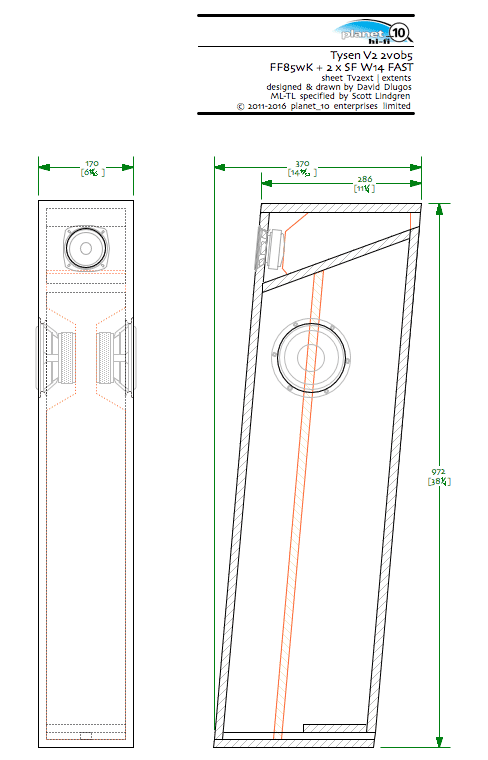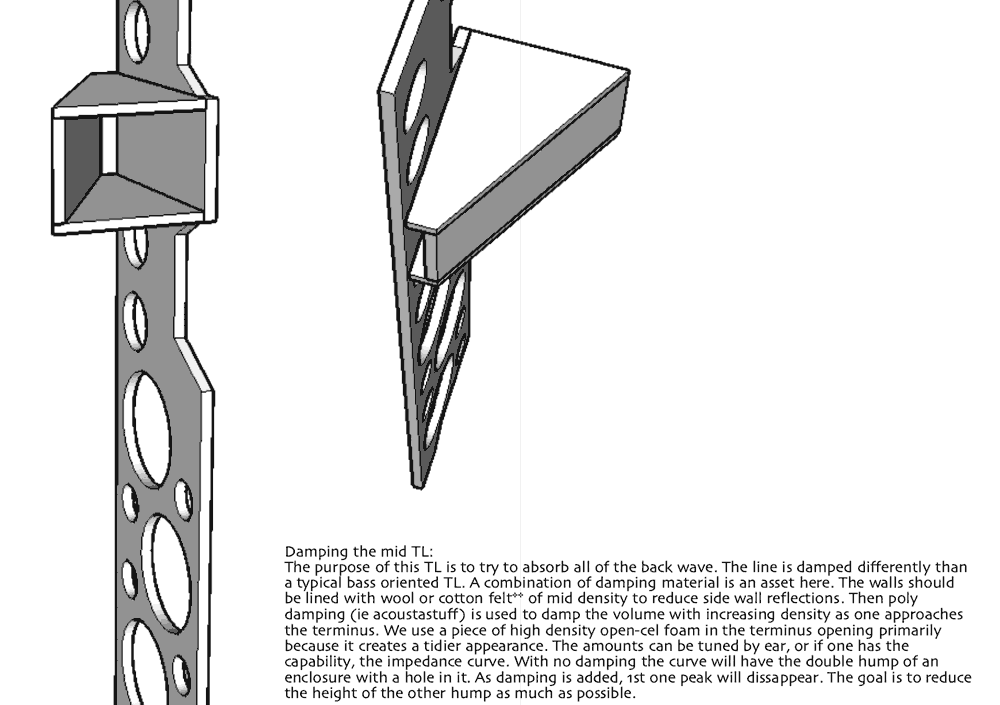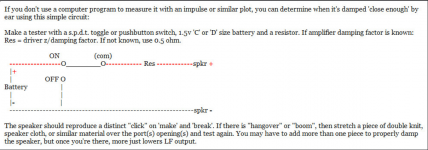I see some builders port the midrange driver out the back of the cab. What's the goal / the end result of this on the midrange ?
Thanks !
John
Thanks !
John
FYI/FWIW, etc., I typically put them in a pipe 'vented' out the back so I could 'critically' damp them to the point of flattening its impedance, ditto open back tweeters.
Either sealed or (my preference), an aperiodic midTL, of which GM’s pipe is an example.
A example of how the impednce can be flattened.

dave
A example of how the impednce can be flattened.
dave
Is that sealed compared to some sort of vent or a free air meaning no cab open back compared to a vent.
Impressive flattening of the impedance.
Impressive flattening of the impedance.
(stated) Free Air and Aperiodic TL. 😉
-I prefer ported to most combinations and usually in a larger enclosure than what a typical .7 Q Sealed would provide. I do this with a port tuning freq. that is about 2 octaves below the driver's high-pass filter. This is done to *reduce losses in the suspension with other designs (and aperiodic designs tend to have greater losses), while **improving damping within the operational bandwidth.
*air-restriction (to some extent the driver in a large ported enclosure behaves a bit more like a free-air result); note that I also do not utilize fibrous "fill" on the interior walls of the enclosure (though I often "fill" in the center of the enclosure).
**the in-box port provides a load on the driver that has far less of a "lossy" character as you would find with an aperiodic design, not only where the driver's in-box resonance is, but a bit below that as well (and that should be well below the high-pass filter's freq.).
The trade-off (beyond an often larger-sized enclosure result), is a more complex Impedance and potentially a more complex filter.
-I prefer ported to most combinations and usually in a larger enclosure than what a typical .7 Q Sealed would provide. I do this with a port tuning freq. that is about 2 octaves below the driver's high-pass filter. This is done to *reduce losses in the suspension with other designs (and aperiodic designs tend to have greater losses), while **improving damping within the operational bandwidth.
*air-restriction (to some extent the driver in a large ported enclosure behaves a bit more like a free-air result); note that I also do not utilize fibrous "fill" on the interior walls of the enclosure (though I often "fill" in the center of the enclosure).
**the in-box port provides a load on the driver that has far less of a "lossy" character as you would find with an aperiodic design, not only where the driver's in-box resonance is, but a bit below that as well (and that should be well below the high-pass filter's freq.).
The trade-off (beyond an often larger-sized enclosure result), is a more complex Impedance and potentially a more complex filter.
^you can do that with a small amount of thick fibrous material near (usually near 1" distance) the interior (enclosure) opening of the port. It takes a bit to get the right distance and material (density/size/etc.) to get the best effect.
This is designed to attenuate higher freq. resonances of the port.
This is designed to attenuate higher freq. resonances of the port.
..at that point it becomes a somewhat resonant aperiodic "port" - which creates air-flow resistance.
When you are just putting absorptive material close to the (internal) port end it's not generating much of any air-flow resistance to the driver.
So you want driver back-pressure, but you don't want driver air-flow resistance (..and yes, back-pressure is necessarily air-flow resistance but the mechanical result isn't the same).
It is true though that you don't really want output from any *resonance contribution of the port, and that the high-pass filter will hopefully attenuate/(lower) that and the attendant driver excursion.
*..though paradoxically I have heard designs that actually sounded better with a bit of rear-out-of-phase leakage (higher in freq.) from the port (..as if it were an open-back speaker) - this is almost always with **larger diameter ports. Rear polars tend to look like cr@p in those instances, but you aren't designing loudspeakers for an objective absolute, but rather user preference. Still, like getting the absorptive material close to the port, it's difficult to get this "dialed-in" - especially when you are also trying to attenuate higher freq. resonances AND ultimately trying to achieve a certain amount of back-pressure vs. signal-level (where port diameter is dependent on both aspects).
**typically a design like this is a (straight) tube a little larger than the driver as the enclosure and a ***bit smaller diameter (straight) tube in that porting-out the rear of the tube enclosure. The tube enclosure is almost always pretty long and is typically way over-sized as far as volume relative to the midrange driver. A design like this is one of those few instances where I've often preferred absorption on the walls of the enclosure's interior (or at least starting from the port entrance (distance-wise) and moving back to the enclosure's rear panel, but NOT near the driver itself).
***like a 6" diameter tube with a 4" diameter port.
When you are just putting absorptive material close to the (internal) port end it's not generating much of any air-flow resistance to the driver.
So you want driver back-pressure, but you don't want driver air-flow resistance (..and yes, back-pressure is necessarily air-flow resistance but the mechanical result isn't the same).
It is true though that you don't really want output from any *resonance contribution of the port, and that the high-pass filter will hopefully attenuate/(lower) that and the attendant driver excursion.
*..though paradoxically I have heard designs that actually sounded better with a bit of rear-out-of-phase leakage (higher in freq.) from the port (..as if it were an open-back speaker) - this is almost always with **larger diameter ports. Rear polars tend to look like cr@p in those instances, but you aren't designing loudspeakers for an objective absolute, but rather user preference. Still, like getting the absorptive material close to the port, it's difficult to get this "dialed-in" - especially when you are also trying to attenuate higher freq. resonances AND ultimately trying to achieve a certain amount of back-pressure vs. signal-level (where port diameter is dependent on both aspects).
**typically a design like this is a (straight) tube a little larger than the driver as the enclosure and a ***bit smaller diameter (straight) tube in that porting-out the rear of the tube enclosure. The tube enclosure is almost always pretty long and is typically way over-sized as far as volume relative to the midrange driver. A design like this is one of those few instances where I've often preferred absorption on the walls of the enclosure's interior (or at least starting from the port entrance (distance-wise) and moving back to the enclosure's rear panel, but NOT near the driver itself).
***like a 6" diameter tube with a 4" diameter port.
Last edited by a moderator:
I wasn't aware of this approach to critically dampen the midrange. Is this done to flatten the impedance and simplify crossover work, or does it also have an impact on how the midrange sounds? I guess a closed box is a damped system tuned with the designed Q, while an open baffle is a non-dampened system.
Any good references that I can read to learn about the approach and the benefits would be appreciated.
Any good references that I can read to learn about the approach and the benefits would be appreciated.
Is this done to flatten the impedance and simplify crossover work, or does it also have an impact on how the midrange sounds?
Better sound is the primary goal, flat impedance is a fortunate side-effect.
dave
Does impedance flattening matter, when running active, or does it only benefit passive filter design?
Yes, but in a completely different role, one being that you can use a current amplifier with impunity.
dave
dave
Great to read this. Would a critically dampened midrange sound more like an open baffle but with the back wave absorbed?Better sound is the primary goal, flat impedance is a fortunate side-effect.
dave
How do I learn so to experiment with this? If I have an 8" midrange, do I build a box and stick a pipe to the back? what diameter, length, length into the box as starting points?
Any good threads about this that come to mind?
Thank you!
open baffle but with the back wave absorbed
Yes, plus flattened impedance. Likely better transient response since it is critically damped.
dave
How do I learn so to experiment with this?
I like to use a 10:1 tapered TL, it easily fits in more boxes. But a round pipe can work (Halcyon is an example).
It is usually pretty easy to have a line long enuff for use as a midTweeter, you want the volume to exceed that of a large sealed box.
The biggest we have built is for a 4”. Have drawings for up to about 6-7”.



dave
@planet10
Thanks for posting all that!
List night I ran a search in this forum and found some references - not many.
Rephrasing to confirm I'm thinking this correctly:
Thank you very much!!
Thanks for posting all that!
List night I ran a search in this forum and found some references - not many.
Rephrasing to confirm I'm thinking this correctly:
- One recommendation was to start with a large enough box such that Fb is at least an octave below the high-pass. I´m running the 8" mid from 250 to 1100Hz, so Fb should be 125Hz max, and within that volume build the transmission line.
- The approach you pasted above to break down that box volume into two transmission lines looks great. Thank you! What's the passband on that driver, BTW?
- A "10:1 tapered TL" means: 10:1 refers to the ratio between the large opening at the mouth of the taper and the small opening at the end, correct?
- Any minimum length criteria I should factor? I'm guessing something in connection with the 250Hz wavelength, but maybe this was already taken care of by the first point.
- Saw in other posts the terminus is sometimes executed on perforated wood covered with damping material on the inside. I guess the high-density open-cell foam referred to in the design posted above serves the same purpose and looks better.
- I guess I will need to learn how to measure impedance curves. Can't do that right now. Any alternative measurement approaches? Can frequency response, distortion measurements, or other with REW and mic help identify the right stuffing and know when I have a decent-enough build? Then I can go and listen and decide if I like it better, know is not a poor build.
Thank you very much!!
1/ An octave lower is a good start, i usually work for more since i like first order XOs, but as always the more overlap the better.
2/ the FF85wk goes from 250 (active) - 450 Hz (the passive) all the way up (doesn’tquite hit the 32k of the predessor), the Silver Flute W14 are good into the 30s. With the wide baffle WAW with the A7 the XO can go as low as 180-200Hz.
3/ 10 at the closed end, 1 at the open end.
4/ you would like to exceed the LF extension goals. Usually that is fairly easy.
5/ an aperiodic midTL typically has increasing density of stuffing as you move towards the terminus. I typically top it of fwith near black open cel foam for cosmetics (and it is a good resistive material)
6/ you can learn a lot from what the impedance curve looks like. If you also want to measure T/S i remommend S+L Woofer Tester 2. But for more casual use there us free stuff.
dave
2/ the FF85wk goes from 250 (active) - 450 Hz (the passive) all the way up (doesn’tquite hit the 32k of the predessor), the Silver Flute W14 are good into the 30s. With the wide baffle WAW with the A7 the XO can go as low as 180-200Hz.
3/ 10 at the closed end, 1 at the open end.
4/ you would like to exceed the LF extension goals. Usually that is fairly easy.
5/ an aperiodic midTL typically has increasing density of stuffing as you move towards the terminus. I typically top it of fwith near black open cel foam for cosmetics (and it is a good resistive material)
6/ you can learn a lot from what the impedance curve looks like. If you also want to measure T/S i remommend S+L Woofer Tester 2. But for more casual use there us free stuff.
dave
- Home
- Loudspeakers
- Multi-Way
- Sealed or ported Mid?
